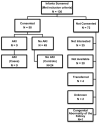Urine biomarkers predict acute kidney injury in newborns
- PMID: 22424940
- PMCID: PMC3598122
- DOI: 10.1016/j.jpeds.2012.02.007
Urine biomarkers predict acute kidney injury in newborns
Abstract
Objective: To identify urine biomarkers predictive of acute kidney injury (AKI) in infants admitted to level 2 and 3 neonatal intensive care units with birth weight >2000 g and 5-minute Apgar score ≤ 7.
Study design: A nested case-control study was performed comparing 8 candidate urine AKI biomarkers in infants with AKI (defined as a rise in serum creatinine of at least 0.3 mg/dL or a serum creatinine elevation ≥ 1.7 mg/dL persisting for 3 days) and 24 infants from the described cohort without AKI. Urine was analyzed for neutrophil gelatinase-associated lipocalin, osteopontin, cystatin C, albumin, β(2) microglobulin, epithelial growth factor, uromodulin (UMOD), and kidney injury molecule 1.
Results: Compared with the infants without AKI, those with AKI had higher levels of urine cystatin C (1123 pg/mL [95% CI, 272-4635 pg/mL] vs 90 pg/mL [95% CI, 39-205 pg/mL]; P < .004; area under the receiver operating characteristic curve [AUC] = 0.82), lower levels of UMOD (11.0 pg/mL [95% CI, 5.7-21.4 pg/mL] vs 26.2 pg/mL [95% CI, 17.4-39.4 pg/mL]; P < .03; AUC = 0.77), and lower levels of epithelial growth factor (6.7 pg/mL [95% CI, 4.0-11.3 pg/mL] vs 17.4 pg/mL [95% CI, 12.7-23.8 pg/mL; P = .003; AUC = 0.82). Although the differences were not statistically significant, levels of urine neutrophil-associated gelatinase lipocalin, kidney injury molecule 1, and osteopontin trended higher in infants with AKI.
Conclusion: Urinary biomarkers can predict AKI in neonates admitted to level 2 and 3 neonatal intensive care units.
Copyright © 2012 Mosby, Inc. All rights reserved.
Figures



References
-
- Aggarwal A, Kumar P, Chowdhary G, Majumdar S, Narang A. Evaluation of renal functions in asphyxiated newborns. J Trop Pediatr. 2005;51:295–9. - PubMed
-
- Gupta BD, Sharma P, Bagla J, Parakh M, Soni JP. Renal failure in asphyxiated neonates. Indian Pediatr. 2005;42:928–34. - PubMed
-
- Karlowicz MG, Adelman RD. Nonoliguric and oliguric acute renal failure in asphyxiated term neonates. Pediatr Nephrol. 1995;9:718–22. - PubMed
-
- Askenazi DJ, Griffin R, McGwin G, Carlo W, Ambalavanan N. Acute kidney injury is independently associated with mortality in very low birthweight infants: a matched case-control analysis. Pediatr Nephrol. 2009;24:991–7. - PubMed
-
- Koralkar R, Ambalavanan N, Levitan EB, McGwin G, Goldstein S, Askenazi D. Acute kidney injury reduces survival in very low birth weight infant. Pediatr Res. 2010;69:354–8. - PubMed
Publication types
MeSH terms
Substances
Grants and funding
LinkOut - more resources
Full Text Sources
Medical
Research Materials
Miscellaneous

